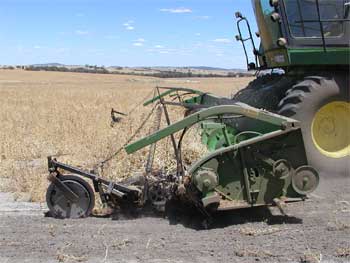South Perth, Western Australia
September 30, 2005
Western
Australian grain growers have been quick to realise the
potential of semi-leafless field pea varieties like Kaspa in
overcoming the harvesting problems of trailing field peas.
The
Department of Agriculture, Western Australia has visited
growers harvesting Kaspa to record the successes and failures as
a guide to new growers. The results are available in Farmnote
14/2005 ‘Successfully harvesting semi-leafless field peas’.
Department pulse researcher Mark Seymour said the
harvesting requirements for semi-leafless varieties were
slightly different than the requirements for trailing varieties.
|
 |
|
Fitting
lupin breakers to the table auger improves the flow of
material and reduces blockages |
“Semi-leafless lines tend to be fluffy at
maturity, having a large volume-to-weight ratio which could lead
to a build-up of material on the front of the header,” Mr
Seymour said.
“This is common on draper-belt fronts, but has
also been observed when Kaspa is harvested with a conventional
header with a plucker front.
“Conventional open front harvesters with a table
auger (tin front) are well suited to both trailing and
semi-leafless peas including Kaspa, but drapers and pluckers
need modification to harvest Kaspa easily and efficiently.”
The major harvesting benefits of Kaspa include:
-
Kaspa can be swathed, and provided the swaths
are rolled immediately, will be stable in windy conditions.
Modifications to swathers which help move material out of
the exit hole will assist.
-
Kaspa can be direct-headed in hot weather.
-
As a result of Kaspa’s sugar pod trait,
losses due to inclement weather or rough handling will be
significantly lower.
-
Harvest samples of Kaspa are significantly
cleaner (less dust and dirt).
Issues to consider when harvesting Kaspa
include:
-
Harvested material moves poorly across draper
fronts and may block the header. Fitting a cross auger with
paddles is the best known modification.
-
Similar issues with barrel pluckers can be
dealt with in two ways – fit lupin breakers to table auger
and harvest at speeds up to 6km/hr or fit a cross auger
which allows for harvest speeds up to 10km/hr.
-
In cool conditions, Kaspa is more difficult
to thresh and many choppers and spreaders may perform
poorly.
The Department of Agriculture has produced a
CD-video which allows growers to view different harvester
set-ups working in Kaspa. This video was available at the
Dowerin and Newdegate Field Days, and will soon be available at
key district offices. |